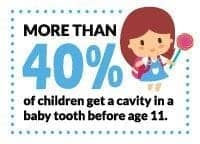If your child has a cavity, you’re not alone! In fact, the Centers for Disease Control and Prevention report that more than 40% of kids get a cavity in a baby tooth before age 11. These cavities happen for a variety of factors, but a common culprit for kids is sugary foods and drinks. The most important things for you to know right now, however, is that the current cavity is treatable and future cavities are preventable.
Three common treatments for a cavity

- Filling. Fillings are the most common treatment. To add a filling, the dentist will remove the decayed portion of the tooth with a drill and fill the hole with a silvery alloy, gold, porcelain, or a composite resin. And, all of these materials are completely safe for your child.
- Crown. If the tooth has decayed enough that not much of it remains, it may require a crown rather than a filling. Your dentist will remove the damaged portion of the tooth and then fit it with a crown made of gold, porcelain, or porcelain fused to metal.
- Root canal. If the root or pulp of your child’s tooth is dead, your dentist will need to remove the nerve, tissue, and blood vessels, along with the decayed portion of the tooth. Also, a sealing material fills in the roots of the tooth, and a crown covers the filling, too.
The best way to prevent cavities is good dental hygiene. But, until your child is managing successfully on their own, help them brush their teeth 2-3 times a day, and begin flossing teeth wherever two teeth are touching.
If you want to learn more about your child’s teeth, check out our post about baby teeth or our FAQ page. If you have additional questions or are worried your child may have a cavity, contact us today to schedule an appointment!
